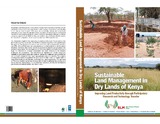| dc.contributor.author | Gachene, CKK | |
| dc.contributor.author | Okelo, JJ | |
| dc.contributor.author | Ngigi, M | |
| dc.contributor.author | Kathumo, V | |
| dc.date.accessioned | 2013-08-01T12:41:34Z | |
| dc.date.available | 2013-08-01T12:41:34Z | |
| dc.date.issued | 20-04-12 | |
| dc.identifier.citation | CKK Gachene, V Kathumo, JJ Okelo and M Ngigi, 2012. The Disappearing Forest: A case study of trends in land use and land cove r change of the threatened Lower Tana River Forest Complex, Coastal Kenya. Paper presented during the PGIS Workshop held on 20 th April, 2012, KARI HQs, Nairo | en |
| dc.identifier.uri | http://hdl.handle.net/11295/53610 | |
| dc.description.abstract | The main cause of land use and land cover changes (LULCC) is through
changes in the way human beings use and manage their land resources. One
of the most vulnerable natural resources most threatened by human beings is
the forest. This study investigated trends in LULCC in the Lower Tana River
Forest Complex (LTRFC) using Remote Sensing (RS) and GIS technology.
The forest is located in the Kenya Coastal lowland and is of considerable
value for both biodiversity conservation and local livelihoods. Analysis was
carried out using multi-temporal images and field based studies, with a view
to understand the dynamics of land use and land cover changes, especially
deforestation and associated agricultural developments activities from 1995
to 2004. During the 9 years period, significant changes occurred in areas
under the forest and agriculture. In 1995, the major land use and land cover
was forest (7185.51 km
2
), grassland (7010 km
2
) and agriculture (243.87
km
2
). The land use and land cover change was quite dynamic within the 9
year period. The forest cover decreased from about 7185.52 km
2
in 1995
to 1852.6 km
2
in 2004, a 74.2 per cent loss. On the other hand, the area
under agriculture increased considerably by almost ten times, from 243.87
km
2
in 1995 to 2346.65 km
2
ha in 2004, a 862.25% gain. This means that
most of the area previously under forest was lost to cultivation. Therefore
there is need for proper land use planning and community awareness on the
implications of this land use and land cover changes. It is also prudent that
the forest management stakeholder in the area come together to collectively
participate in the conservation of Lower Tana River Forest Complex. | |
| dc.language.iso | en | en |
| dc.publisher | University of Nairobi | en |
| dc.title | The Disappearing Forest: A case study of trends in land use and land cove r change of the threatened Lower Tana River Forest Complex, Coastal Kenya. | en |
| dc.type | Presentation | en |
| local.publisher | Department Of Land Resource Management And Agricultural Technology | en |

